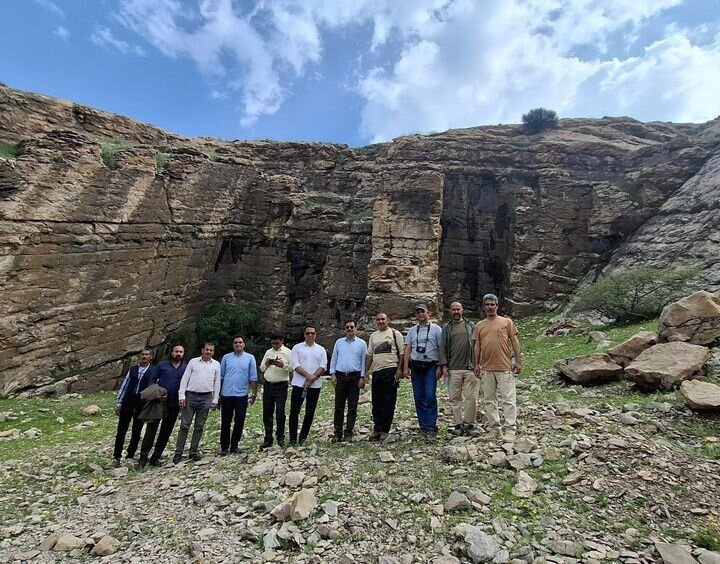Lost quarry believed to supply Achaemenid palace in Susa discovered in western Iran

TEHRAN - In a landmark archaeological breakthrough, Iranian researchers have discovered what is believed to be the long-lost quarry used to source the massive stones for Achaemenid-era masterpieces such as the palace of Darius the Great in the ancient city of Susa.
The site was found near the city of Abdanan in Ilam province, western Iran, and is being hailed as one of the most significant archaeological discoveries in West Asia in recent years.
Mohammad-Ebrahim Zarei, head of Iran's Research Institute of Cultural Heritage and Tourism, announced the discovery during an official visit to Abdanan on Friday. "For over two millennia, the origin of the stones used in Darius's palace remained a mystery. This discovery is astonishing and could solve a 2,000-year-old historical puzzle," he said.
The monumental find was made possible through the efforts of a local teacher, Mohammad Heydari, who first proposed the site, and archaeologist Luqman Ahmadzadeh-Shohani, who led the excavation project. The research team, operating under the Institute's Archaeology Department, combined field surveys, satellite imagery, and geological studies to identify extensive remnants of ancient quarrying operations. Among the findings were stone-cutting tools, extraction evidence, and significant quantities of limestone and iron ore, which may have been used in crafting metal joints for Achaemenid stone architecture.
Historical references to a site named “Abiradush” — mentioned in inscriptions by Darius I as the source of stones for the Apadana Palace — had long intrigued scholars. Until now, its exact location remained unknown. The newly identified quarry in the Kabir Kuh mountains near Abdanan matches the descriptions and is believed to be the fabled Abiradush.
“The Apadana Palace in Susa is one of the most majestic royal structures of ancient Iran. Identifying the true origin of its building materials opens a new chapter in our understanding of Achaemenid construction logistics, architectural planning, and resource management,” Zarei said.
The research team estimates the distance from the quarry site to Susa at roughly 150 kilometers. The stones were likely transported via a complex route combining mountainous roads and riverways, particularly the Karkheh River.
Archaeologists are hopeful that this find will lead not only to a deeper understanding of the Achaemenid Empire’s engineering and architectural achievements but also to the potential nomination of the site for UNESCO World Heritage status. The discovery could spark new avenues in cultural tourism and sustainable heritage development in the central Zagros region.
Although detailed studies are ongoing and more visual documentation is expected to be released, the discovery has already drawn comparisons to the famed Pentelic marble quarries used in building the Parthenon in Athens, Zarei added.
This is not the first Achaemenid quarry to be identified in Iran. Around a decade ago, archaeologists uncovered large-scale stone extraction sites near Pasargadae, including the extensive “Almas-Bori” quarry and others used for building foundational and decorative elements in royal structures.
Experts believe that continued research into these ancient quarrying systems will further illuminate the sophisticated techniques employed by Achaemenid builders — from the extraction of 2- to 50-ton stone blocks, to their transportation by ox-drawn carts, and eventual polishing using date palm fibers and sharkskin.
Susa, a gateway to must-see destinations
The UNESCO-registered Susa was once the winter residence of Persian kings after having been captured by Cyrus the Great. Susa became part of the Persian Empire under Cyrus II, the Great in 538 or 539 BC.
Various archaeological seasons in Susa have yielded ample relics including pottery, arms, ornamental objects, metalwork, bronze articles, as well as clay tablets. Susa is also a gateway to several worthy destinations such as the UNESCO-tagged ziggurat of Tchogha Zanbil, the ruins of Achaemenid Apadana Castle, Shush Castle (Akropol), Prophet Danial Shrine, Museum of Susa, the archaeological mount of Haft Tapeh.
Situated in the lower Zagros mountain range, Susa is identified as Shushan in the Book of Esther and other Biblical books.
To the left of the entrance ramp, follow the self-guided signage past date palms into the excavation site of the 521 BC Palace of Darius, the mighty Achaemenid king.
To the east lies the Royal City, an area of deep excavations through 15 strata; south of the castle is an eroded earthen watchtower overlooking teenagers riding dirt bikes.
Dominating the landscape on the right is the fortress-like Chateau de Morgan (Shush Castle), built on the bones of an Elamite acropolis by the French in the early 20th century to protect their loot from marauding tribesmen. It is not open to the public, but there are fine views from the path around the base, including a view of the Tomb of Daniel from the southern side.
In the Bible, Susa is known primarily from the story of Esther in which Haman the Agagite planned to defeat the Jews of Persia. According to the story, Esther outwitted him by persuading her husband, King Ahasuerus of Persia, to sabotage Haman’s plan. The episode is commemorated every year in the Jewish Purim festival which is marked with costumed parties and other celebrations, according to Ancient Origins.
It is said that Alexander of Macedonia captured Susa in 330 BC and plundered the city, seizing some 40,000 talents of gold and silver from the treasury. Alexander initiated Shushan’s decline by favoring Babylon and shortly after, following a revolt, the city was burnt to the ground. Subsequently rebuilt by Sapor II (309-379 CE), it was renamed Iranshahr Shapur and later helped in the resistance against the Arab invasion of 645.
After the fall of the Achaemenid Empire and the reign of Alexander the Great, who married in Susa, the city became part of the Seleucid empire. It was now called Seleucia on the Eulaeus. A palace in Greek style was erected, next to Darius’ palace. The administrative center, however, was in the southern part of the city, where nearly all Greek and Parthian inscriptions were discovered. In the Parthian age, the city minted coins.
AM
Leave a Comment